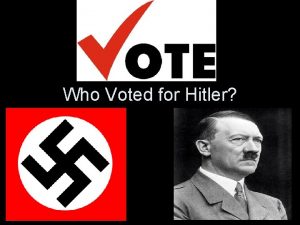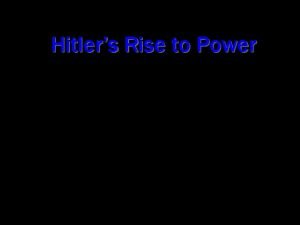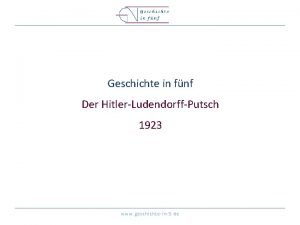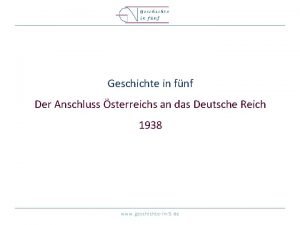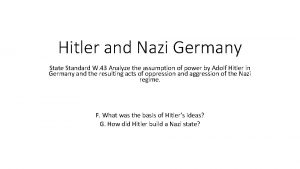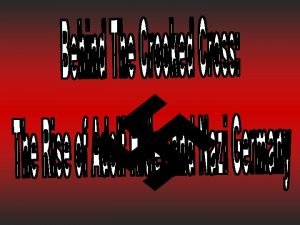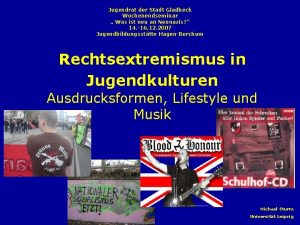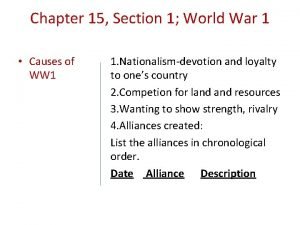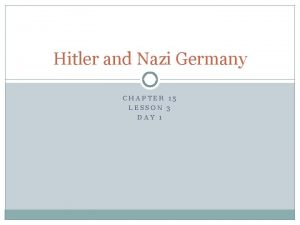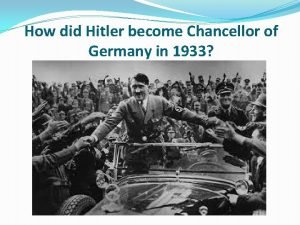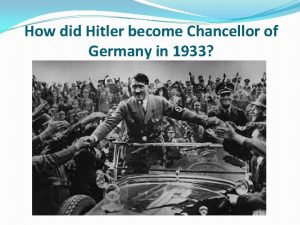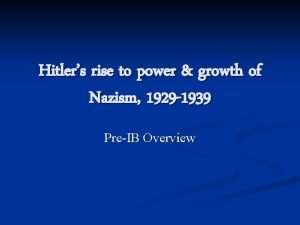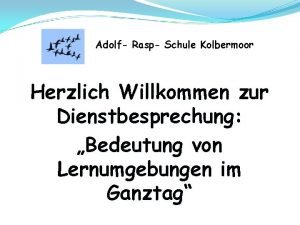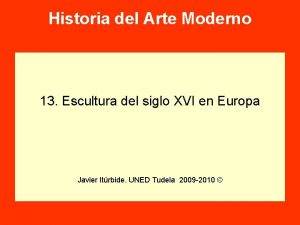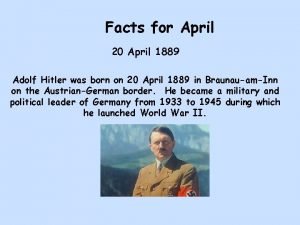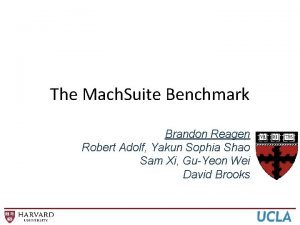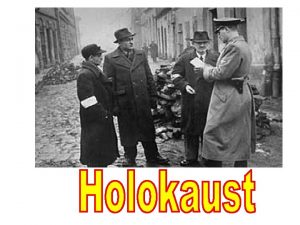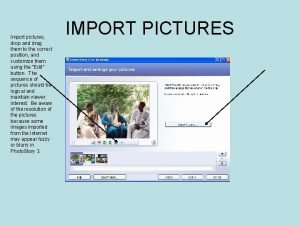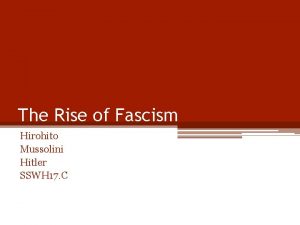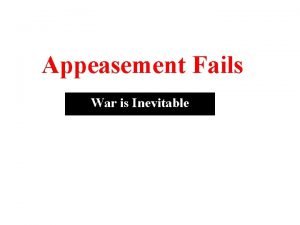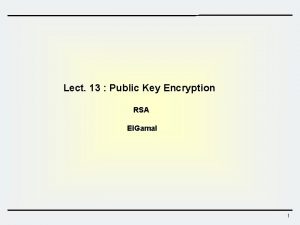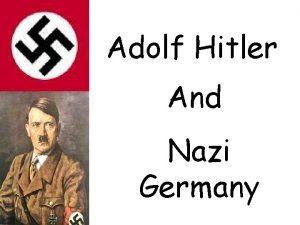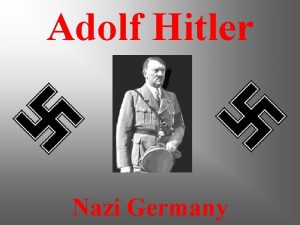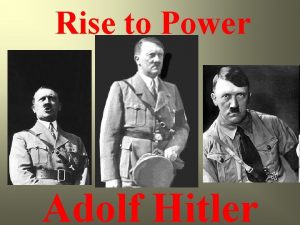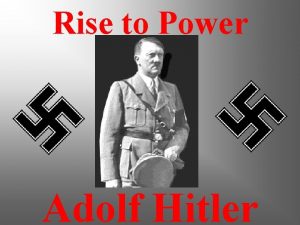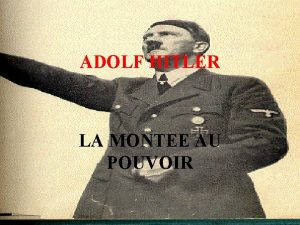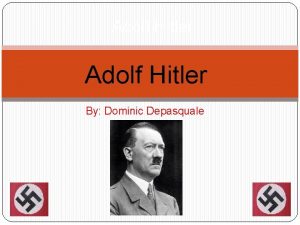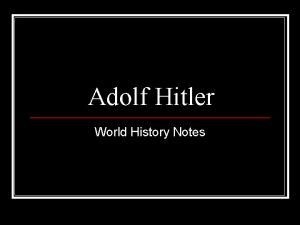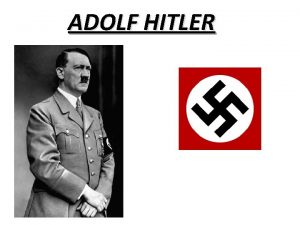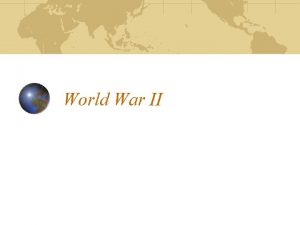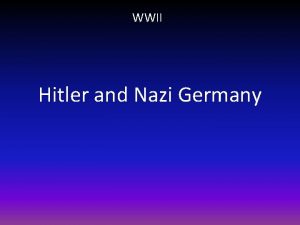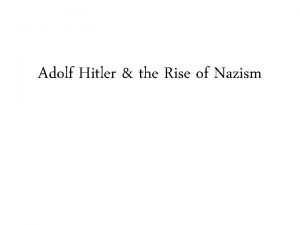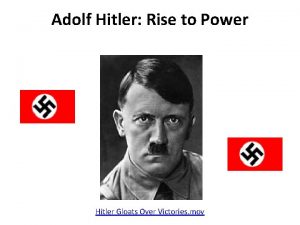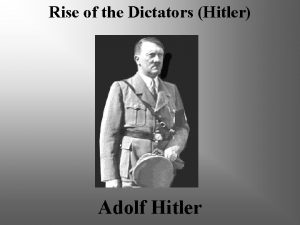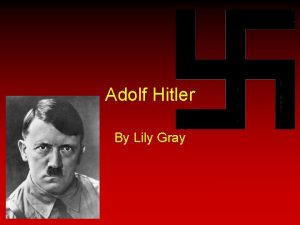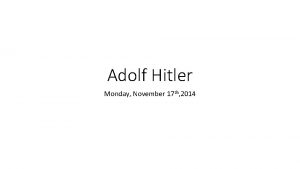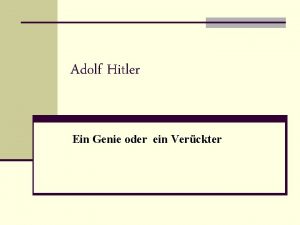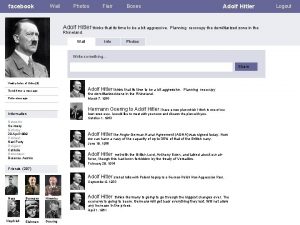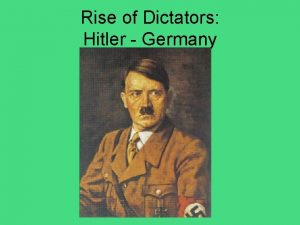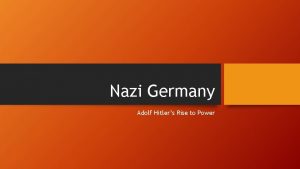Rise of Adolf Hitler and Germany signature Years












![German “Revolutions” [1918] German “Revolutions” [1918]](https://slidetodoc.com/presentation_image_h2/415669822d94bff2c4b0fbd2de3c7508/image-13.jpg)


![The Spartacist League Rosa Luxemburg [1870 -1919] murdered by the Freikorps The Spartacist League Rosa Luxemburg [1870 -1919] murdered by the Freikorps](https://slidetodoc.com/presentation_image_h2/415669822d94bff2c4b0fbd2de3c7508/image-16.jpg)

















![Mein Kampf [My Struggle] Mein Kampf [My Struggle]](https://slidetodoc.com/presentation_image_h2/415669822d94bff2c4b0fbd2de3c7508/image-34.jpg)

![Weimar Germany: Political Representation [1920 -1933] Political Parties in the Reichstag May 1924 Dec. Weimar Germany: Political Representation [1920 -1933] Political Parties in the Reichstag May 1924 Dec.](https://slidetodoc.com/presentation_image_h2/415669822d94bff2c4b0fbd2de3c7508/image-36.jpg)







![The Great Depression [1929 -1941] The Great Depression [1929 -1941]](https://slidetodoc.com/presentation_image_h2/415669822d94bff2c4b0fbd2de3c7508/image-44.jpg)



- Slides: 47

Rise of Adolf Hitler and Germany

signature

Years in Vienna • After his mother died, Adolf (now 18) decided to move to Austria to pursue his dream of becoming a great artist. • Again he failed to gain entrance into the Academy • He eventually sold all his possessions and became a homeless drifter who slept on park benches and ate at soup kitchens throughout Vienna (age 19) • Adolf did manage to sell some paintings and postcards, but remained impoverished

Vienna -Importance • Influenced by the anti. Semitic mayor of Vienna, Karl Lueger • Became interested in the idea of German nationalism. • Also received first taste of politics

Military Service Adolf left Austria at the age of 24 to avoid mandatory military service that was required of all men. But he did sign up for military service at the start of WW I. He joined a Bavarian unit of the German Army. This is a picture of Hitler listening to an enlistment speech.

World War I • Excited to fight for Germany. • Found a home fighting for the Fatherland. • Highest rank held was corporal. • Was a regimental messenger, not an easy job at all.

Military Record • Was awarded the Iron Cross twice. (5 medals overall) • Highest military honor in German Army. • Single handedly captured 4 French soldiers.

Europe in 1919

The “Stabbed-in-the-Back” Theory Disgruntled German WWI veterans

German Loss in WW I • Hitler was devastated when he heard the news of the German surrender. • Believed there was an anti-war conspiracy that involved the Jews and Marxists. • Also, felt that the German military did not lose the war, but that the politicians (mostly Jews) at home were responsible for the defeat.

From the German Point of View Lost—but not forgotten country. ß Into the heart You are to dig yourself these words as into stone: Which we have lost may not be truly lost!

Maimed German WW I Veteran
![German Revolutions 1918 German “Revolutions” [1918]](https://slidetodoc.com/presentation_image_h2/415669822d94bff2c4b0fbd2de3c7508/image-13.jpg)
German “Revolutions” [1918]

German Freikorps

Sparticist Poster
![The Spartacist League Rosa Luxemburg 1870 1919 murdered by the Freikorps The Spartacist League Rosa Luxemburg [1870 -1919] murdered by the Freikorps](https://slidetodoc.com/presentation_image_h2/415669822d94bff2c4b0fbd2de3c7508/image-16.jpg)
The Spartacist League Rosa Luxemburg [1870 -1919] murdered by the Freikorps

Friedrich Ebert: First President of the Weimar Republic

The German Government: 19191920

The German Mark

The German Mark

The French in the Ruhr: 1923

The French Occupation of the Ruhr

Life after WW I • Hitler was depressed after WW I. • Still in the army, he became an undercover agent whose job was to root out Marxists • Also, lectured about the dangers of Communism and Jews

German Worker’s Party • Hitler was sent to investigate this group in Munich in 1919. • He went to a meeting and gave a speech. • He was them asked to become a member, which he did

NAZI Party is Formed • Hitler began to think big for the German Worker’s Party • Began placing ads for meetings in anti-Semitic newspapers • Hitler changed the name to National Socialist German Worker’s Party or the NAZIS

Early NAZI Party

Party Platform • Hitler drafted a platform of 25 points • Revoke Versailles Treaty • Revoke civil rights of Jews • Confiscate Besides changing the party name, the any war red flag with the SWASTIKA was profits adopted as the party symbol

Beer Hall Putsch • October 30, 1923 • Hitler held a rally in Munich beer hall and declared revolution • Led 2000 men in take over of Bavarian Government • It failed and Hitler was imprisoned

The Beer Hall Putsch: 1923

The Beer Hall Putsch Idealized

Hitler in Landesberg Prison

Trial and Jail • At his trial (Hitler was charged with treason), he used the opportunity to speak about the NAZI platform and spread his popularity. • The whole nation suddenly knew who Adolf Hitler was and what he stood for • He was sentenced to five years, but actually only served about 9 months • When he left prison, he was ready to go into action again.

Jail and Mein Kampf
![Mein Kampf My Struggle Mein Kampf [My Struggle]](https://slidetodoc.com/presentation_image_h2/415669822d94bff2c4b0fbd2de3c7508/image-34.jpg)
Mein Kampf [My Struggle]

Mein Kampf • Hitler’s book “My Struggle” - wrote while in jail • Sold 5 million copies, made him rich • Topics included: Jews were evil, Germans were superior race, Fuhrer principal, dislike of Communism and Democracy and need to conquer Russia
![Weimar Germany Political Representation 1920 1933 Political Parties in the Reichstag May 1924 Dec Weimar Germany: Political Representation [1920 -1933] Political Parties in the Reichstag May 1924 Dec.](https://slidetodoc.com/presentation_image_h2/415669822d94bff2c4b0fbd2de3c7508/image-36.jpg)
Weimar Germany: Political Representation [1920 -1933] Political Parties in the Reichstag May 1924 Dec. 1924 May 1928 Sep. 1930 July 1932 Nov. 1932 Mar. 1933 Communist Party (KPD) 62 45 54 77 89 100 81 Social Democratic Party (SDP) 100 131 153 143 133 121 120 Catholic Centre Party (BVP) 81 88 78 87 97 90 93 Nationalist Party (DNVP) 95 103 73 41 37 52 52 Nazi Party (NSDAP) 32 14 12 107 230 196 288 102 112 121 122 22 35 23 Other Parties

Legal Rise to Power • Used popularity from failed revolution and book to seize power legally • Spoke to mass audiences about making Germany a great nation again • Nazi Party: – 1930 = 18% of vote – 1932 = 30% of vote – Hitler becomes Chancellor in 1933

Appeal of Hitler • Germany was in the midst of an economic depression with hyper-inflation • Hitler was a WW I hero who talked about bringing glory back to the “Fatherland” • He promised the rich industrialists that he would end any communist threat in Germany • Constantly blamed Jews for Germany’s problems, not the German people. • Hitler was an excellent public speaker.

Strong Arm Tactics • The “Brownshirts” or SA (Stormtroopers) • SA was used to put down opposition parties • Threatened and beat up Jews and ant-Nazi voters • Wore brownshirts, pants and boots • Numbered almost 400, 000 by 1932

Dictator • “Reichstag fire” gives Hitler total power • In 1933, all parties were outlawed except the Nazi party • People’s civil rights were suspended • “Night of the Long Knives”

Dictator

Absolute Power • German economy was improving, people were happy • Hilter had no political opposition • Began rearming German Army for expansion of the Reich

German Unemployment: 1929 -1938
![The Great Depression 1929 1941 The Great Depression [1929 -1941]](https://slidetodoc.com/presentation_image_h2/415669822d94bff2c4b0fbd2de3c7508/image-44.jpg)
The Great Depression [1929 -1941]

War on the Jews Seventy years ago, on November 9– 10, 1938, the Nazis staged vicious pogroms—state sanctioned, anti-Jewish riots—against the Jewish community of Germany. These came to be known as Kristallnacht (now commonly translated as “Night of Broken Glass”), a reference to the untold numbers of broken windows of synagogues, Jewish-owned stores, community centers, and homes plundered and destroyed during the pogroms. Encouraged by the Nazi regime, the rioters burned or destroyed 267 synagogues, vandalized or looted 7, 500 Jewish businesses, and killed at least 91 Jewish people. They also damaged many Jewish cemeteries, hospitals, schools, and homes as police and fire brigades stood aside. Kristallnacht was a turning point in history. The pogroms marked an intensification of Nazi anti. Jewish policy that would culminate in the Holocaust—the systematic, state-sponsored murder of Jews.

Kristallnacht • http: //www. ushmm. org/museum/exhibit/focus/kristallnacht/videos/

THE END. . . Until the start of World War II
 Hitler birth
Hitler birth Questions to ask hitler
Questions to ask hitler Adolf hitler's family tree
Adolf hitler's family tree Hitler powerpoint
Hitler powerpoint Hitler fnf
Hitler fnf Adolf hitler fnf
Adolf hitler fnf What was the basis of adolf hitler’s ideas?
What was the basis of adolf hitler’s ideas? Adolf hitler was born
Adolf hitler was born Adolf hitler was born
Adolf hitler was born Nazi party
Nazi party Zivilabzeichen sa alpha industries
Zivilabzeichen sa alpha industries Adolf hitler
Adolf hitler Pasojat e luftes se dyte boterore
Pasojat e luftes se dyte boterore Adolf hitler 1984
Adolf hitler 1984 Adolf hitler
Adolf hitler 20 04 1889
20 04 1889 Lesson 3 hitler and nazi germany
Lesson 3 hitler and nazi germany When did hitler become chancellor
When did hitler become chancellor How did hitler become chancellor of germany
How did hitler become chancellor of germany Tricky dick
Tricky dick Hitler rise to power
Hitler rise to power How did hitler rise to power
How did hitler rise to power Rise and rise until lambs become lions
Rise and rise until lambs become lions Raise and rise again until lambs become lions
Raise and rise again until lambs become lions Rise and rise again until lambs become lions origin
Rise and rise again until lambs become lions origin Four score and seven years ago is how many years
Four score and seven years ago is how many years Goat years to human years
Goat years to human years 300 solar years to lunar years
300 solar years to lunar years Arnold adolf berthold
Arnold adolf berthold John heartfield adolf le surhomme
John heartfield adolf le surhomme Adolf rasp schule
Adolf rasp schule Adolf engler
Adolf engler Paula heimann
Paula heimann Adolf daucher
Adolf daucher Jason adolf
Jason adolf Adolf loos steiner house
Adolf loos steiner house Adolf x nica
Adolf x nica Adolf ziegler
Adolf ziegler 20 april adolf
20 april adolf Adolf eichmann anne frank
Adolf eichmann anne frank Robert adolf
Robert adolf Adolf eichmann djeca
Adolf eichmann djeca Drag and drop picture and signature at the correct position
Drag and drop picture and signature at the correct position Hitler hirohito mussolini
Hitler hirohito mussolini Did hitler invent scratch and sniff stickers
Did hitler invent scratch and sniff stickers Hitler and stalin
Hitler and stalin Rsa public-key encryption and signature lab solution
Rsa public-key encryption and signature lab solution Digital signature in cryptography and network security
Digital signature in cryptography and network security

